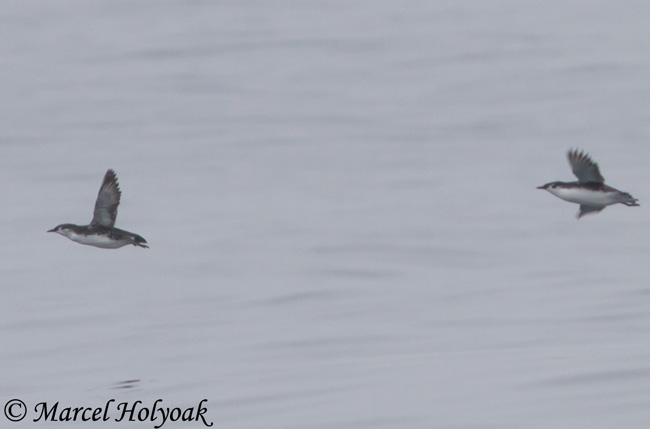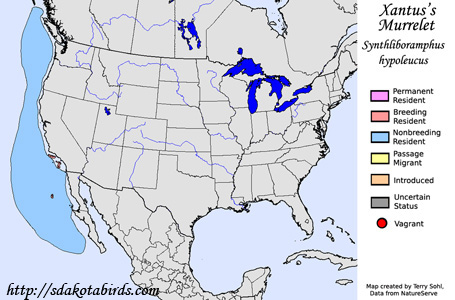| Length: 9.5 inches | Wingspan: 15 inches | Seasonality: Non-resident in South Dakota |
| ID Keys:Dark upperparts, white underparts, dark upperpart of face, white extends upward in front of and on top of the eye (compare to Scripp's Murrelet) | ||
 The
Guadalupe Murrelet is a "new" species, with the
Scripp's and Guadalupe Murrelet's
recently split (2012) from what was formerly considered one species, the
Xantus's Murrelet. They are a very uncommon bird, only found nesting
on a handful of islands from Guadalupe Island in the north, to the San
Benito Islands in the south. Introduced predators such as rats have
devastated some former breeding colonies.
The
Guadalupe Murrelet is a "new" species, with the
Scripp's and Guadalupe Murrelet's
recently split (2012) from what was formerly considered one species, the
Xantus's Murrelet. They are a very uncommon bird, only found nesting
on a handful of islands from Guadalupe Island in the north, to the San
Benito Islands in the south. Introduced predators such as rats have
devastated some former breeding colonies.
Habitat: Found on a few select islands off the Pacific Coast, using locations with protected nesting sites, such as rocky crevices or vegetative cover. Outside of the breeding season, typically found far from the mainland, sometimes close to nesting islands, but often far out to sea.
Diet: Feeds mostly small fish, but will also feed on small crustaceans and other small marine creatures.
Behavior: Forages by diving and swimming under the water in search of food items. Doesn't feed in flocks or by itself, but is almost always found foraging in pairs.
Nesting: The Guadalupe Murrelet doesn't build a nest. The female lays 2 eggs directly on the ground, typically in a rocky crevice, under a bush, or in another protected area. Both parents help to incubate the eggs. Hatchlings typically leave the nest within a day or so after hatching, often making a perilous leap into the water below. Once in the water, the parents reunite with the young and feed and tend to them.
Song: Call of the Guadalupe Murrelet is a rattling trill.
Migration: Breeds on a few islands from Guadalupe Island in the north to San Benito Islands in the south. Non-breeding birds disperse, with most found off the California or northern Mexican coast.
Interactive eBird Map: Click here to access an interactive eBird map of Guadalupe Murrelet sightings
Similar Species: In range, most likely to be confused with Scripp's Murrelet, Craveri's Murrelet, Ancient Murrelet, and Marbled Murrelet.
Conservation Status: Populations have been in a long-term decline. The species has a very small breeding range, and many former breeding colonies have disappeared, largely due to introduced predators on nesting islands, such as rats. The IUCN lists the Xantus's Murrelet as a "Vulnerable" species. (no separate information on Guadalupe Murrelet available at the time this page was created).
Further Information: 1) U.S. Fish & Wildlife Species Profile - Xantus's Murrelet
2) Audubon Guide - Xantus's Murrelet
3) Wikipedia.org - Guadalupe Murrelet
Photo Information: Photo taken by Marcel Holyoak - September 18th, 2010 - Half Moon Bay, California - Photo licensed under Creative Commons Attribution NonCommercial NoDerivs 2.0 Generic License
| Click below for a higher-resolution map |
 |
| South Dakota Status: Non-resident in South
Dakota NOTE: Range map is for Xantus's Murrelet, from which Scripp's Murrelet was recently split. |
Additional Guadalupe Murrelet Photos (coming soon!!)
